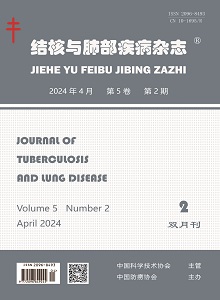-
Analysis of the status of tuberculosis epidemic in demonstration district of Guangdong province
- CHEN Yu-hui,LI Jian-wei, JIANG Li, CHEN Liang, YIN Jian-jun, ZHOU Lin, ZHONG Qiu
-
Journal of Tuberculosis and Lung Health. 2013, 2(4):
249-254.
doi:10.3969/j.issn.2095-3755.2013.04.007
-
 Abstract
(
298 )
Abstract
(
298 )
 PDF (857KB)
(
304
)
PDF (857KB)
(
304
)
 Save
Save
-
References |
Related Articles |
Metrics
Objective To understand the TB epidemiological features of the demonstration district of Guangdong province, in order to evaluate the implementation of TB control measures and provide evidence base for floating population TB control strategies development. Methods The age, sex, occupational and treatment outcome of 3203 active PTB cases were analyzed based on the registered data of the demonstration district in 2012. Results (1)In 2012, a total of 3203 PTB cases were registered, in which there were 2349 cases of floating population, accounting for 73.3%.(2) In all cases, the proportion of male (68.5%, 2195/3203) were more than female(31.5%, 1008/3203). Among the smear positive cases of floating population the female had a higher proportion (32.8%,382/1164) than resident population (27.0%,116/429)(χ2=12.73, P<0.01).(3) In terms of the occupational distribution of TB cases of the floating population cases, domestic chores and unemployed accounting for 47.7%(1120/2349)and more than half both in initial treatment and retreatment smear positive cases. (4) In the new smear positive PTB cases, the sputum negative conversion rate at the end of 2th months (91.9%,351/382) and at the end of 3th months (96.3%,368/382) of resident population were significantly higher than that of floating population(79.8%,776/972;88.8%,863/972) (χ2=28.53,18.92,P<0.01),and that was similar in retreatment cases.(5) The smear positive PTB cure rate was 93.2%(400/429) in resident population which was significantly higher than the floating cases(85.1%,991/1164) (χ2=18.59,P<0.01).The cure rate of new smear positive PTB cases of resident population(94.5%,361/382)was higher than the floating cases (86.1%,837/972)(χ2=18.94,P<0.01). But the treatment failure rate(6.8%,79/1164) and cases loss rate(3.4%,39/1164)of smear positive PTB cases were higher in floating population than that of resident population(1.9%,8/429;0.9%,4/429) (χ2=14.71,6.78,P<0.01). Conclusion The demonstration area still have high TB burden in floating population. So we should further improve floating population TB prevention and control strategies.

 Wechat
Wechat